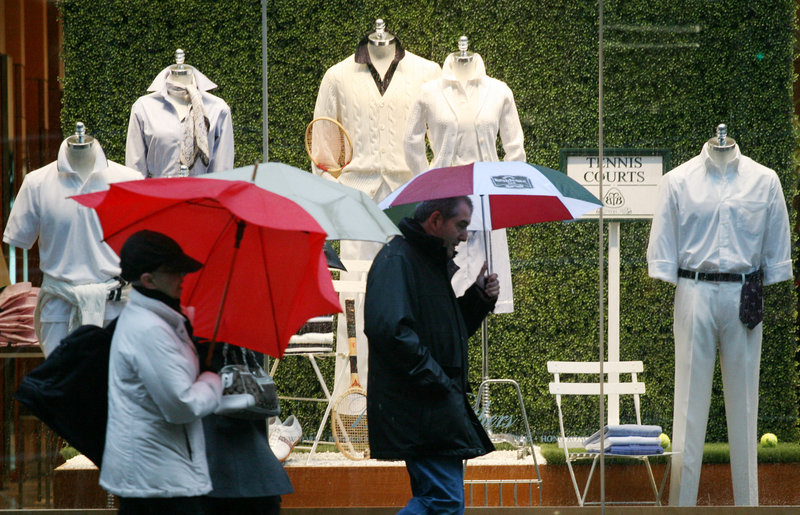NEW YORK – Discounter Walmart Stores Inc. isn’t the only company taking steps to buy more goods made in America.
It’s also on the minds of luxury and upscale retailers and brands.
With the industry under pressure to respond quickly to fashion trends and seeking to shorten the period between designing a product and getting it on store shelves, there’s a growing appeal to buying U.S.-made products, retailers say.
Increased labor costs in markets such as China, high import duties, fluctuating currency exchange rates and uncertainty over volatile fuel costs make manufacturing in the United States more attractive. Add in questions about quality and recent evidence that worker conditions in some countries remain unsafe and the result is that more and more companies have started to look seriously at buying more domestically manufactured goods.
“There are opportunities to test products” made in America, Brooks Brothers Chief Executive Claudio Del Vecchio said in an interview, adding that the percentage of the apparel retailer’s made-in-the-U.S. stock as part of the total has increased. “It’s part of our culture to support American manufacturing. We like to buy from America.”
Brooks Brothers, which makes 70 percent of its suits in a Massachusetts factory, 100 percent of its ties in New York and 15 percent of its shirts in North Carolina, is also looking at increasing the manufacturing of its men’s shoes and accessories in the United States, he told MarketWatch. The company’s website has a section that touts only made-in-America products.
With the sputtering U.S. job growth rate, the industry, at the National Retail Federation’s annual convention earlier this week, called for its members to do their part to support U.S. jobs. Walmart U.S. CEO Bill Simon, in a keynote speech at the convention, said the retail giant is buying an additional $50 billion U.S.-made products over the next 10 years. It plans to do this by increasing orders for things such as paper and sporting goods it already buys domestically but also by helping to bring back production textiles, furniture and higher end appliances.
At luxury retailer Saks Inc., Chief Executive Steve Sadove said while its customers of traditional European luxury labels care more about the brands and their quality and workmanship, Saks also has been increasing domestic sourcing in its “contemporary brands,” which usually refers to brands that are considered younger and hipper and carry a more affordable cost.
“We are seeing a resurgence in ‘Made in America’ in contemporary” brands, Sadove said in an interview. “We are increasing sourcing there because you can get replenishment much more easily (through) supply chain in America.”
In a Brunswick Group survey of more than 200 U.S.-based investors interested in the luxury sector, 80 percent of them said the reputational risk associated with offshore manufacturing is beginning to offset the cost savings for luxury goods manufacturers.
“A lot of our (luxury) clients talk about bringing sourcing back home,” said Susan Gilchrist, group chief executive at communications firm Brunswick Group, at a Financial Times Business of Luxury panel Thursday. “It’s not just about publicity. The actual (cost) differential gap is really closing.”
Marcus Wainwright, head designer for the contemporary apparel label Rag & Bone, said more than 60 percent of its products are made in the United States — and at a profit.
“To have flexibility and nimbleness is incredible in the U.S.,” he said at the presentation. “There’s something intangible and valuable. It’s more about craftsmanship and authenticity than margin and profit.”
At designer house Vera Wang, high-end wedding gowns are also made in America.
“It’s almost impossible to do the dress elsewhere,” Mario Grauso, president of Vera Wang, said at the panel. “We have 12 weeks to deliver the dress. We don’t want to disappoint the bride. Our high-end customers care where it’s made.”
Copy the Story Link
Send questions/comments to the editors.



Success. Please wait for the page to reload. If the page does not reload within 5 seconds, please refresh the page.
Enter your email and password to access comments.
Hi, to comment on stories you must . This profile is in addition to your subscription and website login.
Already have a commenting profile? .
Invalid username/password.
Please check your email to confirm and complete your registration.
Only subscribers are eligible to post comments. Please subscribe or login first for digital access. Here’s why.
Use the form below to reset your password. When you've submitted your account email, we will send an email with a reset code.